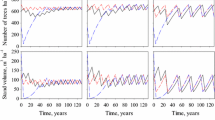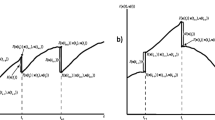Abstract
In forest harvest scheduling problems, one must decide which stands to harvest in each period during a planning horizon. A typical requirement in these problems is a steady flow of harvested timber, mainly to ensure that the industry is able to continue operating with similar levels of machine and labor utilizations. The integer programming approaches described use the so-called volume constraints to impose such a steady yield. These constraints do not directly impose a limit on the global deviation of the volume harvested over the planning horizon or use pre-defined target harvest levels. Addressing volume constraints generally increases the difficulty of solving the integer programming formulations, in particular those proposed for the area restriction model approach. In this paper, we present a new type of volume constraint as well as a multi-objective programming approach to achieve an even flow of timber. We compare the main basic approaches from a computational perspective. The new volume constraints seem to more explicitly control the global deviation of the harvested volume, while the multi-objective approach tends to provide the best profits for a given dispersion of the timber flow. Neither approach substantially changed the computational times involved.






Similar content being viewed by others
References
Bertomeu M, Diaz-Balteiro L, Giménez JC (2009) Forest management optimization in Eucalyptus plantations: a goal programming approach. Can J For Res 39:356–366
Bettinger P, Sessions J, Johnson KN (1998) Ensuring the compatibility of aquatic habitat and commodity production goals in Eastern Oregon with a Tabu Search procedure. For Sci 44:96–112
Brumelle S, Granot D, Halme M, Vertinsky I (1998) A Tabu Search algorithm for finding good forest harvest schedules satisfying green-up constraints. Eur J Oper Res 106:408–424
Buongiorno J, Gilless JK (2003) Decision methods for forest resource management. Academic Press, New York
Caro F, Constantino M, Martins I, Weintraub A (2003) A 2-opt tabu search procedure for the multiperiod forest harvesting problem with adjacency, greenup, old growth, and even flow constraints. For Sci 49(5):738–751
Chalmet LG, Lemonidis L, Elzinga DJ (1986) An algorithm for the bi-criterion integer programming problem. Eur J Oper Res 25:292–300
Clements SE, Dallain PL, Jamnick MS (1990) An operational spatially constrained harvest scheduling model. Can J For Res 20:1438–1447
Cohon JL (1978) Multiobjective programming and planning. Academic Press, New York
Constantino M, Martins I, Borges JG (2008) A new mixed integer programming model for harvest scheduling subject to maximum area restrictions. Oper Res 56(3):542–551
Crowe K, Nelson J, Boyland M (2003) Solving the area-restricted harvest-scheduling model using the branch and bound algorithm. Can J For Res 33(9):1804–1814
Davis LS, Johnson KN, Bettinger P, Howard T (2001) Forest management. McGraw-Hill, New York
Diaz-Balteiro L, Romero C (2003) Forest management optimisation models when carbon captured is considered: a goal programming approach. For Ecol Manag 174:447–457
Diestel R (2000) Graph theory. Graduate texts in mathematics. Springer, Berlin
Diwekar U (2008) Introduction to applied optimization. Springer, Berlin
Falcão AO (1997) DUNAS—a growth model for the National Forest of Leiria. In: Empirical and process-based models for forest tree and stand growth simulation. September 97, Portugal
Falcão AO, Borges JG (2002) Combining random and systematic search procedures for solving spatially constrained forest management scheduling models. For Sci 48(3):608–621
Geoffrion AM (1968) Proper efficiency and the theory of vector maximization. J Math Anal Appl 22:618–630
Gómez T, Hernández M, Molina J, León MA, Aldana E, Caballero R (2011) A multiobjective model for forest planning with adjacency constraints. Ann Oper Res 190(1):75–92
Goycoolea M, Murray AT, Barahona F, Epstein R, Weintraub A (2005) Harvest scheduling subject to maximum area restrictions: exploring exact approaches. Oper Res 53(3):90–500
Goycoolea M, Murray AT, Vielma JP, Weintraub A (2009) Evaluating approaches for solving the area restricted model in harvest scheduling. For Sci 55(2):149–165
Gunn EA, Richards EW (2005) Solving the adjacency problem with stand-centered constraints. Can J For Res 35:832–842
ILOG (2007) ILOG CPLEX 11.0—user’s manual
Jamnick MS, Walters KR (1993) Spatial and temporal allocation of stratum-based harvest schedules. Can J For Res 23:402–413
Martins I, Constantino M, Borges JG (1999) Forest management models with spatial structure constraints. Working Paper No 2/1999, CIO, Faculdade de Ciências de Lisboa
Martins I, Constantino M, Borges JG (2005) A column generation approach for solving a non-temporal forest harvest model with spatial structure constraints. Eur J Oper Res 161(2):478–498
McDill ME, Rebain SA, Braze J (2002) Harvest scheduling with area-based adjacency constraints. For Sci 48(4):631–642
Murray AT (1999) Spatial restrictions in harvest scheduling. For Sci 45(1):45–52
Murray AT, Weintraub A (2002) Scale and unit specification influences in harvest scheduling with maximum area restrictions. For Sci 48(4):779–789
Neter J, Kutner MH, Nachsteim CJ, Wasserman W (1996) Applied linear statistical models, 4th edn. Irwin, New York
O’Hara AJ, Faaland BH, Bare BB (1989) Spatially constrained timber harvest scheduling. Can J For Res 19:715–724
Roise JP (1990) Multicriteria nonlinear programming for optimal spatial allocation of stands. For Sci 36:487–501
Romero C, Rehman T (2003) Multiple criteria analysis for agricultural decisions. Elsevier, Amsterdam
Ross T, Soland R (1980) A multicriteria approach to the location of public facilities. Eur J Oper Res 4:307–321
Steuer RE (1989) Multiple criteria optimization: theory. Computation and application. Wiley, New York
Vielma JP, Murray AT, Ryan DM, Weintraub A (2007) Improving computational capabilities for addressing volume constraints in forest harvest scheduling problems. Eur J Oper Res 176(2):1246–1264
Ware GO, Clutter JL (1971) A mathematical programming system for the management of industrial forests. For Sci 17:428–445
Weintraub A, Cholaky A (1991) A hierarchical approach to forest planning. For Sci 37(2):439–460
Yoshimoto A, Brodie JD (1994) Comparative analysis of algorithms to generate adjacency constraints. Can J For Res 24:1277–1288
Acknowledgements
This research was partially supported by Centro de Investigação Operacional (through the project POCTI/ISGL/152) and Centro de Estatística e Aplicações from Universidade de Lisboa. We wish to thank Andres Weintraub and José G. Borges (through the project PTDC/AGR-CFL/64146/2006) for providing some real test forest data.
Author information
Authors and Affiliations
Corresponding author
Rights and permissions
About this article
Cite this article
Martins, I., Ye, M., Constantino, M. et al. Modeling target volume flows in forest harvest scheduling subject to maximum area restrictions. TOP 22, 343–362 (2014). https://doi.org/10.1007/s11750-012-0260-x
Received:
Accepted:
Published:
Issue Date:
DOI: https://doi.org/10.1007/s11750-012-0260-x
Keywords
- Forest harvest scheduling
- Area restriction model
- Volume constraint
- Integer programming
- Multi-objective programming




